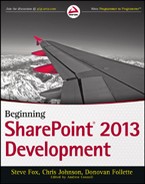THE BIG NEW FEATURES FOR SHAREPOINT DESIGNER
SharePoint Designer (SPD) has been the mainstay for SharePoint workflow creation. In SharePoint 2013 SPD has advanced its feature set for making workflow design easier, and in some cases, just more enjoyable to work with (as you will experience). Also, although you could stitch together workflows in SharePoint 2010 to do some very powerful things, a number of features, actions, and programming constructs were not available to give you the type of control over the “flow” in workflow that you really wanted and needed. SPD fills these gaps. Following is a list of some of the big new features you’ll experience in SPD 2013; these were highly requested features from Microsoft partners and customers alike:
- Visual Designer: For those who prefer a visual design surface with which to build their workflow, SharePoint Designer has a new Visual Designer. However, you must have Microsoft Visio Professional 2013 installed on your computer to use it.
- Stages: You no longer need to use just linear workflows that go from top to bottom as with SharePoint 2010. Human business processes are not strictly linear. Typically these processes have a number of tasks to be performed as a unit of work and processes generally include one or more units of work. When a unit of work is completed, sometimes there is a pause for a period of time before the next unit of work is triggered. Other times the business process needs to return to a previously completed unit of work to have its steps performed again, or it might proceed on to the next unit of work in a linear fashion. In human processes, business rules and policy guide the transitions between one unit of work being completed and what the next unit of work to be started should be. SharePoint 2013 workflows can now better parallel these human process patterns by representing a unit of work as a specific set of workflow actions within a stage. In your workflow, once a stage, (that is, unit of work), is complete, you can choose the next stage for your workflow to transition to, or whether to pause, return to a stage previously completed for further processing, or continue on to the next stage in a linear flow. Therefore, stages give you the flexibility to logically determine your transition from one stage in your workflow to the next.
- Call Web Services: You can now extend your workflows to reach data beyond the boundaries of SharePoint. You can reach out to different systems using HTTP/REST and bring the external data you need into the context of your workflow process.
- Copy/Paste: In SharePoint’s Text-based Designer and the new Visual Designer, you can now copy/paste individual lines or complete constructs.
- Looping: You can loop by using the transition between stages to continue to go to a specific stage unless a specific criterion is met. You can also use the two new loop structures — one describes a determinate loop, the other an indeterminate loop.
- Dictionary Variable: This new variable data type is suited for storing complex data, such as a JSON object returned from a REST call or an array of data.
- Portability: Any workflow type can now be packaged as a .wsp file for redeploying from site to site. You can export your SharePoint Designer workflow into a Visio .VSDX file and import it into another site as well.
- App Step: This contains actions that run with app-level permissions in your workflow. This means that these actions can run outside of the users’ permissions if your workflow needs to perform some action on behalf of users where they do not have that level of permission.
- Interoperability: This provides support for interoperability with classic SharePoint 2010 workflows. Sometimes you might need to use a 2010 action inside of a SharePoint 2013 workflow, but these two workflow engines are inherently incompatible. Two actions are available in SharePoint Designer 2013 — Start a List Workflow, and Start a Site Workflow. With them, you can pass parameters into a SharePoint 2010 workflow, and the 2010 workflow can execute its actions and return data to the 2013 workflow that you can use for its processing.
Hopefully these new feature descriptions have whetted your appetite for wanting to get your hands on the tools, so let’s take a look at them.
